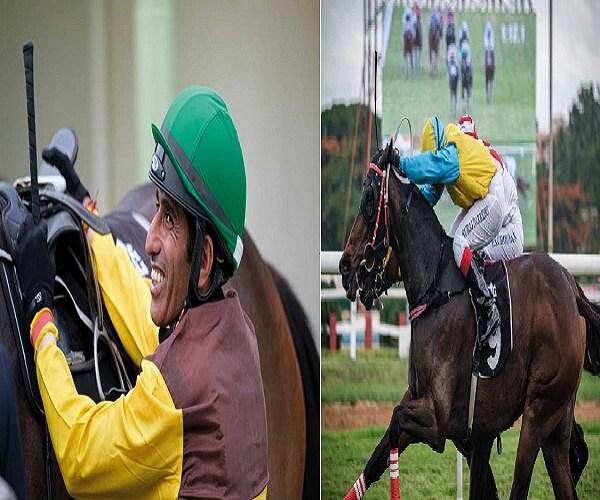When P. S. Chouhan woke up and checked his weight on Saturday morning, the scale said 54 kg, two more than he could be if he wanted to ride Glorious Days, his first horse on July 6, the fifteenth day of Bengaluru’s summer racing season.
Every horse is assigned a weight it can carry, depending on age, form, and the nature of the race, which means a jockey is often focused not just on shaving seconds while racing but also grams before a race. Chouhan spent a few hours in early morning “track work” or exercise with the horses, went home, rested, stretched, said his daily prayer. By then he’d dropped to 53 kg.
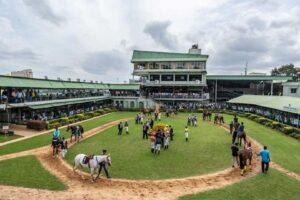 At noon he was back at the Bangalore Turf Club, where he retreated every 15 minutes over the course of an hour to the sweatbox—a stifling 70 degrees Celsius room designed to extract every extraneous drop of water from the human body—to lose another kilo. At 2 p.m. he skipped on to the electronic weighing machine as clerk of the scales Victor D’Souza clipboard in hand, leaned to check the reading: 52 kilos. Perfect.
At noon he was back at the Bangalore Turf Club, where he retreated every 15 minutes over the course of an hour to the sweatbox—a stifling 70 degrees Celsius room designed to extract every extraneous drop of water from the human body—to lose another kilo. At 2 p.m. he skipped on to the electronic weighing machine as clerk of the scales Victor D’Souza clipboard in hand, leaned to check the reading: 52 kilos. Perfect.
It was a slightly overcast but pleasant day, as the horses circled the paddock, their manes trimmed, backs freshly saddled. Chouhan and trainer S. Dominic stood side by side and conferred about the upcoming 1,400m race as trainers and jockeys around them were doing.
Chouhan was done with Glorious Days and was about to ride Desert Angel, a four-year-old filly, notorious for her slow starts. He was a little concerned. In her last race in June, Desert Angel had “planted”, or stood stock-still at the gate, losing time as the rest of the field tore ahead. Chouhan and Dominic—who had worked together previously—discussed how he would prepare accordingly.
He climbed on, his 5’4” frame distinctive in green spotted racing colours with green sleeves and a hooped cap, name stitched on his white breeches, and trotted her to the starting line along with the eleven others.
Chouhan hasn’t ingested a morsel since dinner the previous night, and he wouldn’t until dinner later that night. But there was little time to think of the past or the future, his family in Pune, or his 1,750-odd wins, Desert Angel’s last race or his next one, because his life was here: this moment, these next 90 seconds, this track, this whip, this horse.
At 3.30 p.m., the starter called out: “All in”. He pressed a button. The twelve blue gates cracked open. Desert Angel lunged to the front.
At14 seconds, Desert Angel was in the lead. Chouhan was slightly surprised.
At 40 seconds, Desert Angel approached the 700m mark, still slightly ahead of Chula Vista. He had no choice but to maintain the pace.
At 1.02, she was in front by two lengths. The straight remained. Would she have enough? He wasn’t sure. “Chula Vista is on the outside, starting to bridge the gap on every stride,” the race caller boomed over the microphone.
Chouhan couldn’t hear the commentary or the crowds, only the pounding of hoof on turf and the shouting of the other jockeys.
At 1 minute 9 seconds, in the last two hundred metres, Chula Vista gave chase. Chouhan cracked the whip harder and harder, impelling Desert Angel on as he bounced up and down. But she had nothing in the tank. He realised it was done.
“Chula Vista from Desert Angel, Chula Vista from Desert Angel, Chula Vista from Desert Angel,” the caller boomed, breathless.
At 1 minute 26.99 seconds, Chula Vista crossed the line. “Chula Vista comes away from Desert Angel….”
Adrenaline slowly draining, heart rate easing, Chouhan turned and steered her to the paddock, goggles hanging around his neck, feet off the stirrups. If he was disappointed at finishing second, it wasn’t immediately apparent. When he dismounted, Dominic, bespectacled and in a navy blue suit, was waiting for him for a post-mortem of the race. Dominic nodded as he listened to Chouhan. “It was just bad luck I got the lead,” Chouhan told him. “I couldn’t save her.”
Chouhan went back into the jockeys’ room where, as the rules mandated, his weight was once again noted. Then he went to swap his green colours for the deep purple Maltese cross and hooped cap for the fourth race of the day.
At 41, P. S. Chouhan is older than most jockeys here this weekend, and in his 23-year career has raced in eight courses across the country, pushing and punishing his body in unimaginable ways. Growing up in Pali district in Rajasthan, he took to riding following his uncle’s fondness for horses. That passion drew him to learn riding in Mumbai in 1997 at 16. At 18, he got his licence from the Royal Western India Turf Club. (Apprentice licences are usually granted following riding school and work with a horse trainer.)
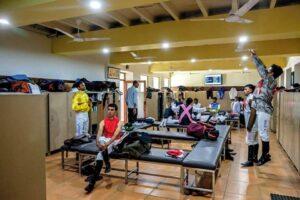 Now Chouhan is president of the Jockeys Association of India with about 500 members, so he has a sense of not just what it takes to have a long career in racing, but the broader landscape of what the sport itself demands.
Now Chouhan is president of the Jockeys Association of India with about 500 members, so he has a sense of not just what it takes to have a long career in racing, but the broader landscape of what the sport itself demands.
Beyond the fancy feathers, the thrill of gambling, the one-per cent lifestyle associated with horse racing, the jockey—the actual man on the actual horse—around whom the rest of the circus pulses and heaves; that man’s life is a dangerous, punishing, exacting thing.
What does it take? India’s jockeys are a tiny breed of men—there are no active women jockeys right now—who navigate a terrific and terrible mix of dieting, injuries, early bed-times, record race-times, anxiety and travel, more anxiety and more travel. But also the pleasure of being wind-whisked, horse-borne, blood surging, mud flying, studs whinnying, time stalling.
I first met Chouhan some months earlier at the Mahalaxmi Race Course in Mumbai along with two other jockeys, Joy Chinoy and Ryan Marshall. They had just finished working the horses and by way of an introduction, Chinoy was about to demonstrate the dark art of guessing someone’s weight. “I can look at his face and say whether he has put on or lost weight,” said Chinoy, 35, a Mumbai-based jockey, pointing at Chouhan on his right. He rocked his chair back and squinted slightly, as everyone swivelled to take a look at Chouhan’s sallow mug with his hooked nose and slight sideburns. He delivered his ruling. “He’s looking quite fit.”
That January morning they were huddled around a table for a special breakfast event at the course, a Breakfast of Champions kind of meal. Cornflakes trapped in glass mounds, hunks of bread, tankards of coffee, eggs of all persuasions, dosas being lifted off hot griddles.
In the middle of this spread, the men, relaxed and jolly, were talking about food. Not the eating of it, but the not-eating of it. Because before some races what’s the first casualty in the diet?
“Food,” said Marshall, a Bengaluru-based jockey, through mouthfuls. He waved his hand gesturing to the table. “All of it.” Chouhan and Chinoy laughed.
Sweets and rice must be avoided. Between races jockeys might just take a few sips of water, or place a single piece of ice in the mouth. But after a race they tank up again on fluids or have a good meal, quickly regaining the weight.
Normally he skipped breakfast, but today Marshall, was eating hearty because he didn’t have a race soon. At 42, he exuded the breezy insouciance of a man with 800-odd wins. “We guys have been doing this all our lives, 25 years I’ve been doing it man,” said Marshall, who at 5’9”, is taller than the average jockey, takes his tea green and his coffee black. “There are times I have not eaten three or four days in a row, just lived on a few apples, oranges and biscuits.”
Beyond the fancy feathers, the thrill of gambling, the one-per cent lifestyle associated with horse racing, the jockey—the actual man on the actual horse—around whom the rest of the circus pulses and heaves; that man’s life is a dangerous, punishing, exacting thing.
A few days later, I met Chinoy again over breakfast (without the breakfast). In two days he had a race, but his square-jawed, youthful face betrayed little tension. Today he was 54 kilos, by Sunday he had to be under 52. No big deal. “If you tell a normal person you have to lose two kilos today he will say no chance I can’t do it, but that’s the thing with us,” he said. “Two kilos?” He shrugged. “I can easily do it.”
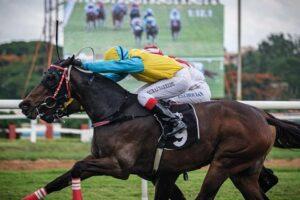 At 5’6”, a compact body wrapped in a thin jacket, for the next 48 hours he would stick to soups, salads and fruits in small portions. He would perhaps use the sweatbox on race day, a trip that could help shed one, two or even three kilos in an hour or two. “Like roasting a chicken in an oven,” Imran Chisty, another jockey had replied when asked to describe the sensation of sitting in that room.
At 5’6”, a compact body wrapped in a thin jacket, for the next 48 hours he would stick to soups, salads and fruits in small portions. He would perhaps use the sweatbox on race day, a trip that could help shed one, two or even three kilos in an hour or two. “Like roasting a chicken in an oven,” Imran Chisty, another jockey had replied when asked to describe the sensation of sitting in that room.
A former two-time apprentice champion who runs about 8 or 10 km a day at least thrice a week, Chinoy tries to maintain a regular routine to avoid extreme measures before a race. After 20 years of this, he knows his body well.
He believes he is more likely to lose weight if he drinks room temperature water rather than cold water. He believes a roast chicken is better than chapattis. He also knows when he is feeling too light-headed or dehydrated or cramped and needs to drop out of a race. “If I can’t hear or control my horse, it can be risky for me, but for the other boys also,” he said.
Chinoy grew up in Mumbai, falling in love with the course when his grandfather took him there on walks. His father was the manager of Gallops, the legendary racecourse restaurant for more than a decade, and even now runs a restaurant in Pune—a particularly ironic fact, all things considered.
Top athletes in all sports shift the boundaries of human capacity, but perhaps racing is tougher than most. The pendulum of weight loss and gain that makes for their extreme lifestyle has come up for scrutiny in the West. In the US and Europe, experts have warned against the use of “heaving bowls”, or self-vomiting utensils at race courses, abuse of diuretics and laxatives. This is still a developing conversation with new studies on eating disorders, addictions and long-term health problems that plague jockeys.
Horse racing was first introduced to India by the British in Madras in the 1770s. Gradually in the 1800s, clubs came to be formed in the major colonial cities to administer racing. India has five “classic races” per season in every centre during the winter, the most prestigious events in the calendar.
Jockeys are licensed club-wise, and eligibility could involve meeting age and weight requirements, undertaking “mock races” and completing apprentice school. India’s most accomplished jockeys have included Pesi Shroff, now a trainer, Aslam Kader and Vasant Shinde, who had a legendary rivalry through the Eighties. Each won more than 1,500 races over their long and storied careers, and between them more than 250 classics. Today’s star jockeys include A. Sandesh and Trevor Patel, men who ride India’s champion steeds in the hopes of making their owners rich and proud.
Owners buy thoroughbreds from stud farms when they are between one and a half and and two years old, with prices usually starting around ₹5 lakh. Groomed and trained by licensed trainers they start racing towards the end of two years, competing on average every three weeks. Their monthly upkeep could cost between ₹25,000 and ₹60,000. “A trainer is like the coach of the team, except the players under you are horses,” said S. Padmanabhan, a Bengaluru-based trainer.
Owners, upon the recommendation of trainers, usually invite jockeys to mount a particular horse. “You pick the best available jockey,” said Padmanabhan. “It’s like picking Virat Kohli for your team. If he isn’t available you pick K. L. Rahul or Rohit Sharma. In fact, I think Rohit is better than Virat.”
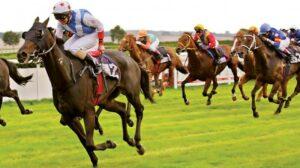 Horses do not race beyond the age of eight or nine, and the retirement age for a jockey is 58, subject to the annual licence renewal process. Though most successful jockeys are in their twenties and thirties, a fit jockey could keep racing deep into his forties, as Chouhan intends to.
Horses do not race beyond the age of eight or nine, and the retirement age for a jockey is 58, subject to the annual licence renewal process. Though most successful jockeys are in their twenties and thirties, a fit jockey could keep racing deep into his forties, as Chouhan intends to.
Jockeys get a fixed ₹2,250 “mount fee” for riding a horse on any course, regardless of where it finishes. Prize money for the top three finishes varies from race to race: from a few lakhs to a few crores for the marquee event, the Indian Derby (the amount fluctuates depending on sponsorship). What a jockey earns depends on where his horse finishes, and this is about 8 per cent of the prize money. About 10 per cent goes to the trainer and the rest to the owner. That Bengaluru weekend for instance, the highest winning amount was ₹6.1 lakh and the lowest ₹1.9 lakh.
The final piece of the ecosystem is the public, and derby days could see capacity crowds of around 20,000, jousting, heaving, eager to make a buck. Betting has been legal since the Supreme Court in 1996 ruled that horseracing was a legitimate sport that involved a punter’s skills and not mere luck.
The betting system has its own byzantine codes, but the most basic bets involve predicting which horse will win, or which position a certain horse will finish at. Generally, bets can be placed either through the tote, a computerised betting system run by the clubs, or through licensed bookmakers who sit at the course.
In Bengaluru for instance, transaction values through the tote could vary between ₹2.5 crore and ₹3.5 crore on race day (the club doesn’t track the value through bookmakers). V. Harimohan Naidu, the chairperson, pointed out that in the last financial year the annual turnover was ₹850 crore, down from ₹2,000 crores previously, a fall he attributed to the introduction of 28 per cent GST.
All afternoon spectators can be found poring over little pocket bibles and pamphlets containing notes on the horses’ pedigrees, performances and veterinary reports. (These books also contain charming cliches about runners that might “add spice to the finish” be “a force to reckon with” or “upset all calculations”.)
Before everything else comes the handicap a horse carries. It is a simple enough concept, where horses are assigned different ratings based on their merit. This in turn determines the weight a horse will carry. The idea is to help level the field. For instance, if a horse is assigned 56kg, in order to ride it a jockey has to be about 54kg, so that along with the saddle and other paraphernalia he will be 56kg.
Generally, higher rated horses carry greater weights. For instance, if a horse is assigned 60 kg, and a jockey is only 58kg even after counting breeches, boots, helmet and so on, he will carry additional lead weights while riding.
Handicapping, or assigning ratings, is done by designated handicappers of each club after studying a horse’s recent performances, health, nature of the race. As a result, a horse’s rating and the weight it can carry keeps changing depending on its performances. Usually every turf club has at least one handicapper assigned to the task.
 This means that the odds a bookmaker assigns to a horse are arrived at after factoring in the handicap. So betting is is not as hit and miss an affair as it seems at first sight. Still, though studying the horse’s career and form lie at the crux of betting, the jockey and the trainer too, are factors in helping people place bets. So every time a jockey rides a favourite, enormous expectations and sums of money are riding on him.
This means that the odds a bookmaker assigns to a horse are arrived at after factoring in the handicap. So betting is is not as hit and miss an affair as it seems at first sight. Still, though studying the horse’s career and form lie at the crux of betting, the jockey and the trainer too, are factors in helping people place bets. So every time a jockey rides a favourite, enormous expectations and sums of money are riding on him.
Every day, jockeys are up by 5.30 a.m., hit the track for three-odd hours for different kinds of workouts with the horses, then they may exercise or return home. Afternoons are usually free or spent watching races, but many jog or walk in the evenings. Some swim, cycle or do yoga, always conscious of avoiding muscle mass. “You have to be dedicated, talented, and fit. At the finish line fitness counts. If a rider gets tired, his horse will automatically slow down,” said Chouhan, on what makes a good jockey. “A jockey has to be able to read what a horse is asking for. If you are a good rider you will understand what he wants.”
Like any sport, years of training and practice are compressed into moments. “In a race run at 70 kph, you have to think as though you are walking at 2 kph,” said Milan Luthria, member of the managing committee and steward of the Royal Western India Turf Club (RWITC) that covers Mumbai and Pune. “It’s like a batsman facing a fast bowler. His hand-eye coordination might take a split second, but it’s as if he’s doing it very, very slowly. A good jockey will think slow in a fast race.”
Races could be anywhere between 1,000m and 3,000m and every course has its own character and topography. A race is not simply a bolt from start to finish. It requires a coalition of guile, talent, stamina, and study.
“We aren’t right every time,” said Chinoy. “We get fractions of seconds to decide what to do, whether to go in or out or take this gap. It may not be the best decision, or you may get lucky.”
Before a race, jockeys scrutinise the field, a horse’s recent races, what it likes or doesn’t, the best distance to maintain, how to pace themselves. “A good horse makes a good jockey,” said Marshall. “Knowing your horses makes a good jockey.”
At the end of Saturday, Chouhan packed up his breeches and shoes, changed into smart casuals and headed home. After eating a bit of chicken for dinner, he spent two to three hours watching old videos and studying for Sunday, when he would be riding Doctor Logan, Southpaw, Marco Polo and Sahara. Marco Polo and Sahara had both finished second in their previous races, Chouhan noted, so he had high expectations for them. “They had been knocking on the door,” he said. “So there was a chance.”
At midnight on Saturday Chouhan went to bed finally, getting up by 6 a.m. out of habit, even though he wasn’t going for track work that morning. The horses he would be racing were of a higher weight category, so he did not have to starve. Arriving at the course in the afternoon, he found his name on a computer-generated list with nine others, randomly picked for a mandatory breathalyser test. India does not yet conduct doping tests.
One by one the men presented themselves in a corner of the jockeys’ room to breathe into a standard issue device as chief medical officer Dr. Thejesh P. E. checked that their blood alcohol levels were within permissible limits. Chouhan passed, as did everyone else. Dr Thejesh had not found anyone in his 12 years of conducting it who had failed.
Chouhan wasn’t in the first two races of the day, so he milled around, looking relaxed, until it was time to get ready for his 1,400m race at 3.30 p.m. Over his sleeveless white vest he slipped on the royal blue colours with purple sleeves and headed to the paddock to chat with the trainer. Aeolus, the horse starting beside him, was a favourite, but according to the racing booklet, Doctor Logan stood “a competitive chance”.
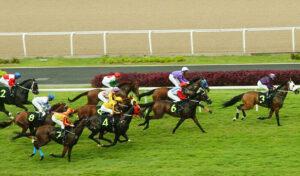 When the horses neared the finish line, Chouhan was in second place, body hunched and almost hovering, right hand plying the whip vigorously, a wave of human beings surging against the wire mesh. The shouting and stomping grew louder and louder, interspersed with cheers and jeers. A few voices shouted, “Chouhan, thatha”, alluding to the man’s age. Someone yelled “oldie”.
When the horses neared the finish line, Chouhan was in second place, body hunched and almost hovering, right hand plying the whip vigorously, a wave of human beings surging against the wire mesh. The shouting and stomping grew louder and louder, interspersed with cheers and jeers. A few voices shouted, “Chouhan, thatha”, alluding to the man’s age. Someone yelled “oldie”.
“We are used to it,” Chouhan later said. “You have to take it, and younger jockeys sometimes don’t take it well. People abuse your family, they don’t leave your daughters.” But he could also sympathise—after all they had money at stake.
Aloof from the excitement, S. A. Javed, an elderly spectator, one of the 8,000-odd here today, was having none of it. As the horses thundered past, Javed, 64, a stocky, balding man with bushy eyebrows grimaced. “Humbug,” he muttered.
He hadn’t bet on this race as he’d dropped ₹22,000 the previous day, placing one useless wager after another. “People are losing money betting on the name of the jockey,” he said. “Trevor, Sandesh, Chouhan, these people are there to make a profit for the club not the public.”
He rocked backwards clutching his fists as if abruptly pulling back a horse. “That is what they do,” he said, miming. “They pull back suddenly at the finish.” Javed, who was turfed out by his parents when he was 31 for his betting habit, came to the course daily. “Magnetic,” he said, summarising its life-long appeal. His best performance: when he earned ₹1.8 lakh in a day in Mumbai in 2012.
A group began to gather as he settled into his pantomime, abusing the jockeys, the club, and his own damn luck. “It is better not to bet but simply bring the money and give it as a donation to the club.”
The crowd vigorously agreed with him. Except for Javed, no one wanted to give their name, much less talk about betting, given that they had come to the course secretly, and were losing daily. “If I was a consistent player I would be there”—said one man gesturing to the balcony above where the wealthy sat—“not here”—the cheap stands on the ground.
Upstairs, in the more rarefied air, Sharmila Padmanabhan, bejewelled and in a black pantsuit removed her sunglasses and whipped out her binoculars as she counted down until the evening’s penultimate 1,600m race. She had grown up with horses; her parents had owned them and now she owned eight. “It’s the thrill, the glamour, the excitement,” she said. “And of course, the money.”
Today she was rooting for Ekalavya, with whom her husband Padmanabhan had worked and who would be up against Marco Polo, ridden by Chouhan. When the race began, she breathed sharply and clucked, seemingly displeased by what she could see from afar.
By the 1 minute 30 mark, Marco Polo had bolted and separated himself from the field, opening up a yawning gulf. Chouhan cracked the whip as his backside flew up and down the saddle with growing urgency. As he crossed the finish line he lifted himself up, balancing almost entirely on his haunches while Marco Polo slowed down. Ekalavya surged in the last 100 metres, and eventually finished second. “Second again!” sighed Sharmila. “Maybe he should run the 2,000m.”
For the past few months Chouhan has been stationed in Bengaluru, the only club with a summer racing season. Ordinarily, he is retained to Jaydev Mody, a Mumbai-based owner, but this weekend he was free to race for anyone, since Mody had no horses in the fray.
Racing will resume in Mumbai from November, and in the winter season races are virtually continuous across the nine centres. This means jockeys move constantly between Mumbai, Delhi, Chennai, Bengaluru, Hyderabad, Kolkata, usually catching a flight in the morning, finishing four or five races, catching a flight back home at night and getting up again for track work the next day. Chouhan has cut down his travel from six times a week to three or four now. “Yes it is stressful, but the demand is like that, can’t help it,” he said.
Jockeys might also be freelancers, moving between stables with every race. But you can’t take all the offers you get, and jockeys make strategic decisions based on winning chances and their feel for a horse. This might mean you give up a horse that doesn’t suit you and later watch it win with someone else. “It happens a lot. You just let it go,” said Marshall. “It’s like being a cricketer. A ball is bowled and you do something different and get out. Mistakes happen. Every jockey and every sportsperson learns by the mistakes.”
The more races you run, the more money you can make, the higher stakes races you get, the bigger the earnings. A handful at the top could make as much as `8-10 lakh a month. At the lower end it might start at ₹20,000.
But winning isn’t just about crossing the finish line, for early career riders it’s about making it to the starting line in the first place. “One kind of difficulty is to get enough rides to make ends meet,” said Luthria, the RWITC steward. “You do have a fairly large number of boys who are licensed to ride but not all end up getting as many rides as they need, or we would like them to get.”
Despite being a champion apprentice jockey, Chouhan suffered a fallow period in 2003, with just a single win, as he tried to establish himself in a competitive field. “In between I went through a bad patch after a fall,” he said. “I felt there were many better riders in Mumbai so I wasn’t getting an opportunity to prove myself.”
Now, as association president for nine years, Chouhan has seen first-hand the darker side–jockeys bed-ridden, paralysed or simply unable to survive. He cautioned against glamorising the profession. “There are boys who can’t buy their daily meals,” he said. “Because there are so many jockeys licensed by clubs, they aren’t getting rides.”
On Saturday afternoon when Chouhan crossed the finish line in the second race, as the horses slowed to a canter, he saw a riderless horse tailing them.
That was when he realised a rider had gone down and he hurried to ask the others what had happened. Estella, squeezed in the scrum of pounding horses had stumbled near the 850m mark sending Amyn Merchant tumbling off. In the video replays he looked like he had been trampled on, but he got off with minor bruises. “He was lucky, anything could happen,” said Chouhan. Later that day another rider fell near the same spot.
Chouhan recounted his own injuries: the big three. Pune: spleen burst in 2003. Bengaluru: jaw broken in 2008. Kolkata: hand injured in 2015. He pointed to a scar running along his mouth on the right side of his face, a mark that was camouflaged as a dimple. He laughed at the comparison. “It’s part of the game, you have to accept this,” he said.
Jockeys are cavalier. “I can’t count,” said Marshall. “I have broken everything in my body.” One fall took him out for seven months, leaving him with a lot of time to do nothing but think. So he thought.
“A lot of things wander through your head. Should I get back, should I do it again? I have a wife and kid. What if something happens? But at the end of it you have to get back to your job.”
This is a sport that has claimed lives and limbs, across geographies, across history; a few seconds could separate prosperity from paralysis. Most famously, Karl Umrigar, a champion 18-year-old jockey died in Bombay after an accident on the racecourse in 1979; his family later instituted a trophy in his name. Death is an occupational hazard. Since 1990, 15 jockeys have died and about 100 forced out of racing because of disability or serious injuries.
“Men in the army are risking their lives every day,” said Marshall. “After them, I think racing is the most stressful or dangerous profession. Our boys are also risking their lives every day.”
One Sunday on race day last season in Mumbai, Chinoy finished two races and took a tumble on his third. Both he and the horse went down, and the rest of the field tore past, deftly avoiding him. Then one straggler came after everyone and went straight over the ribcage of a supine Chinoy, leaving him with a hairline fracture.
He was taken straight before the doctor where he insisted he was fine, despite the pain, and convinced the doctor he was well enough to ride the next three races. “You don’t want to miss out on the big ones,” he said. “Your owners are depending on you. I came running from the dispensary, I didn’t want them to change the jockey.”
The next day he was taken in a wheelchair to Breach Candy Hospital and was out two months after that. “I wanted to overcome the fear that develops after a fall,” he said. “For the first few months after an injury you have that fear. You won’t take a gap or go close to a horse. I didn’t want that to take over.”
Chinoy’s worst injury—from a bike accident—reduced him to a spectator for a year as his peers raced through the season. “You ride this horse every day and I’m seeing my horses win, it’s a very dirty feeling,” he said. “It makes you feel low.”
Jockeys have insurance, through the clubs and the association, and their medical costs are taken care of when they are injured. For instance, those licensed from the RWITC have mediclaim coverage of ₹5 lakhs, and in case of death or disability getty get ₹15 lakh (₹7.5 lakh from the company and ₹7.5 lakh from the club).
But time lost is money lost. “You don’t get paid a rupee during that period,” said Marshall. “We sit it out…Trust me, it’s a headache, a pain. It’s how you handle it.”
Life is often an unbroken stretch of high-fibre, low-fun choices, punctuated by occasional indulgences. The body is too precious, and demands extra precautions. Socialising has to be foreshortened. Bedtime could be as early as 8 p.m. Chinoy doesn’t do “stupid” things like playing football before a race day or speed on his bike. Many don’t smoke or drink.
Despite everything; the restraints, the risks and the rigour, why do they do it? Passion is the word bandied around. Jockeys love horses, not simply as engine rooms to power them to the finish, but as creatures with idiosyncrasies and personalities. Every morning a jockey might ride five to 15 horses, with some of them he has built a relationship, some that are new to him.
Chinoy visits the stables some evenings to see the horses in off-duty hours. “The more time you spend with horses the better you understand them,” he said. “When you go to the stables they may look different. You need to see them more and be around them more to get to know them better.”
Jockeys often drop out of school before they finish Class 12, joining riding school for a two-year programme by the time they are 16. Most spoke of being smitten by the racetrack at an early age, of butting up against parental opposition in their choice of career. Chinoy bunked school and lied to his mother when she was away on work. Marshall forged his mother’s signature on a club membership form. These stories were narrated with the nostalgia-tinted romanticism of hindsight: the bounder tossing it all up, to scrape a career of blood and sweat and broken bones.
In India jockeys work in relative obscurity. Star jockeys do not have the wattage of cricketers or badminton players or even weightlifters and boxers.
What they trade for in celebrity they earn in job satisfaction. “If you go elsewhere to ride a horse you have to pay, but here you get paid,” said Chouhan.
The pleasures are visceral; the headrush, the speed, that feeling of oneness of man and beast. “I know lots of guys who ride bikes. I tell them there is nothing like real horse power between your legs,” said Marshall. “I ride bikes, I love them too. But a horse between your legs—it’s different, it’s thrilling, it’s lovely.”
When Sunday was wrapped up, Chouhan hadn’t done too badly for the weekend: two wins, three second place finishes. He was pleased, and by the time he had changed into a white shirt and jacket, he was already looking forward to resting, eating well and catching up with family.
On Monday and Tuesday he would study each of the weekend’s races, parsing each move he did or did not make. By Thursday he would know which horses he was racing the following weekend. On Friday he’d study again for the next ones.
But once the prep was done, the chats with the trainers over, the weights sorted, the gates shut, it would simply be about riding through a time capsule of 90 or 100 seconds. What had gone before or would come after would cease to matter in the moment of coursing through the track, head bent, gaze straight, back hunched. It would be just him, and the horse and seven or ten other men and their horses, with the finish line in the distance.
“When I am on the horse I am just enjoying my ride,” he said. “That gives me the kick.” #KhabarLive

